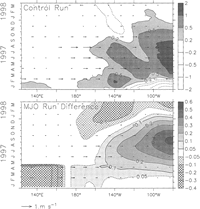
The sense of the rectified SST changes seen in the OGCM was to cool the western Pacific under the strong oscillating winds, and to slightly warm the region east of the direct forcing. From the point of view of the low-frequency coupled system, probably the most important effect is the consequent weakening of the zonal SST gradient, since that gradient is a major influence driving equatorial easterlies. The usual central Pacific SST gradient is about -0.5 to -1°C (1000 km)-1, but the rectification induced in the OGCM by oscillating winds produced a much flatter SST region from about 155°E to 180°. We hypothesize that this SST gradient anomaly could feed back to the coupled system by weakening the background easterlies in this region and thereby enhancing the growth of El Niño.
To test this idea, an intermediate coupled model (section 2b) was used to compare two parallel experiments: a control run that ran freely following initialization to 1 January 1997 (just before the rapid growth of the 1997-98 El Niño), and a run designed to simulate the rectified SST changes found in the OGCM. Since the simplified dynamics and thermodynamics in this coupled model do not encompass the nonlinear processes noted to be important in the OGCM (section 3b), the oceanic effect of these processes was imposed externally. This imposed signal consisted of only the rectified (low-frequency) part of the OGCM SST. Intraseasonal variations themselves played no part in the coupled model experiments. The rectified SST was estimated as the net change in OGCM SST over four MJO cycles; that is the SST difference field over the 60 days centered on 31 August of model year 4 (Fig. 3), smoothed in x, y, and t. Values of this smoothed SST difference ranged from a cooling of up to -0.36°C (along the equator west of about 160°E) to a warming of 0.11°C near 1°N,175°W. Coupled model SST was pushed toward this field for the first four months of 1997 by a strong Haney relaxation with a timescale of 1.74 days (Fig. 7, bottom). Except for this imposed forcing, the model ran freely in coupled mode, parallel to the coupled control run that was otherwise identical but without the externally imposed MJO SST.
Figure 7. SST (shading and contours) and zonal winds (vectors) on the equator during the coupled model runs. (top) control run hindcast initialized to 1 Jan 1997. (bottom) Difference between the control run and the run with the OGCM SST imposed. Note the different contour intervals in each panel.
Figure 7 compares the coupled control run hindcast of the 1997-98 El Niño (top) with the difference due to the hindcast with rectified MJO SST (bottom). The control run (top) predicted a weak warm event that raised SST in the eastern equatorial Pacific by a little more than 1°C, peaking in July-August 1997 and decaying at the end of the year. Anomalous westerly winds in this run were up to 1 m s-1 (Fig. 7, top). In common with several forecasts made at the end of 1996, the tendency toward a warm event in 1997 was clear but the magnitude was much too weak.
The externally imposed rectified MJO signal can be seen in the difference field as a cooling in the far west during January-April 1997, with weak warming near the date line (Fig. 7, bottom). The consequent weakening of the coupled model's zonal SST gradient produced additional westerly winds of about 0.5 m s-1, blowing from the cooler west to the slightly warmer central Pacific, that strengthened the growing westerlies of the warm event (Fig. 7, bottom). This anomaly propagated eastward, with Kelvin waves deepening the thermocline to the east of the imposed cool SST and thereby producing warming in the central Pacific. This SST pattern generated additional westerly winds that continued and extended the eastward motion. Although Kelvin waves ensured that the propagation was eastward, the coupled SST-zonal wind anomaly propagated at about 1 m s-1, much slower than the free Kelvin wave speed (Fig. 7, bottom). The net result was a coupled amplification of hindcast east Pacific SST at the height of the El Niño by more than 0.5°C, or about a 50% increase compared to the control run (Fig. 7, bottom).
The coupled model used here does not include the effects of zonal advection on SST as this was found to have little impact on model forecast skill (Kleeman 1993). Nevertheless, some authors (e.g., Picaut et al. 1997) have argued that zonal SST advection is important to the development of El Niño, so we repeated the experiment with this effect included (see Kleeman 1993 for details on how this is achieved). We found that the sensitivity shown in Fig. 7b was slightly enhanced but the results were qualitatively the same.
Return to previous section or go to next section